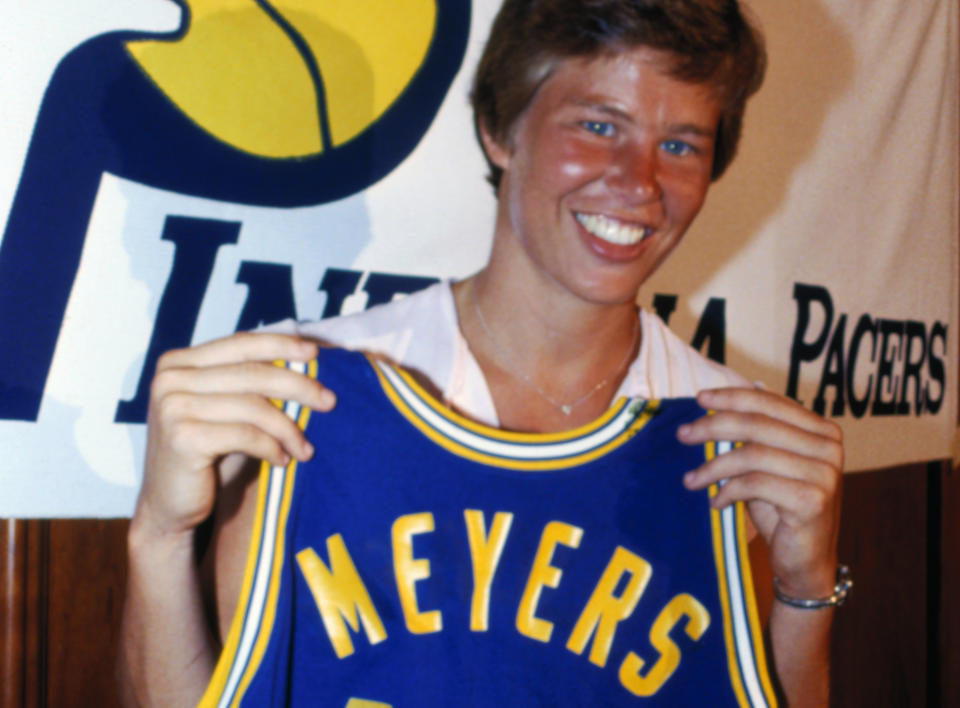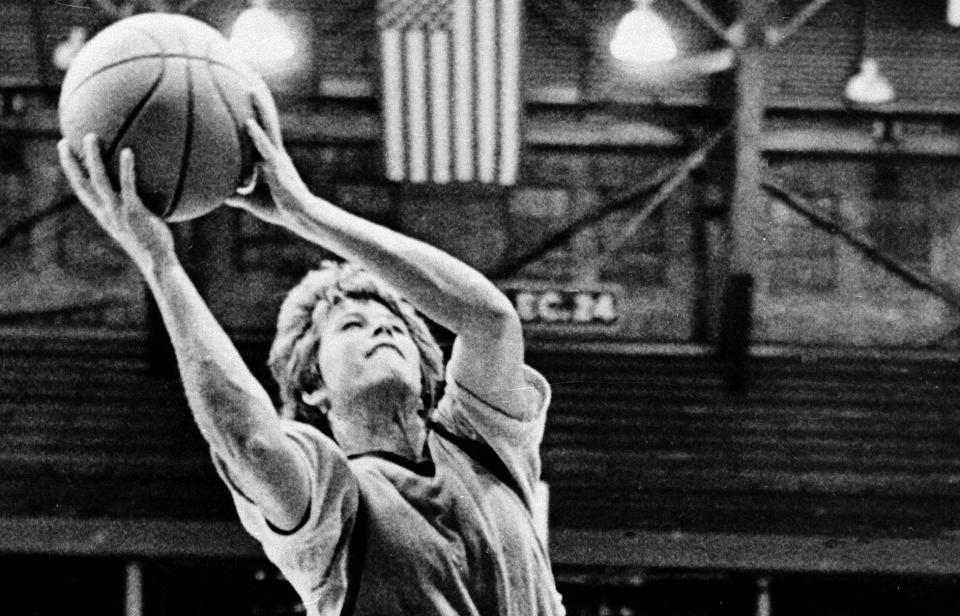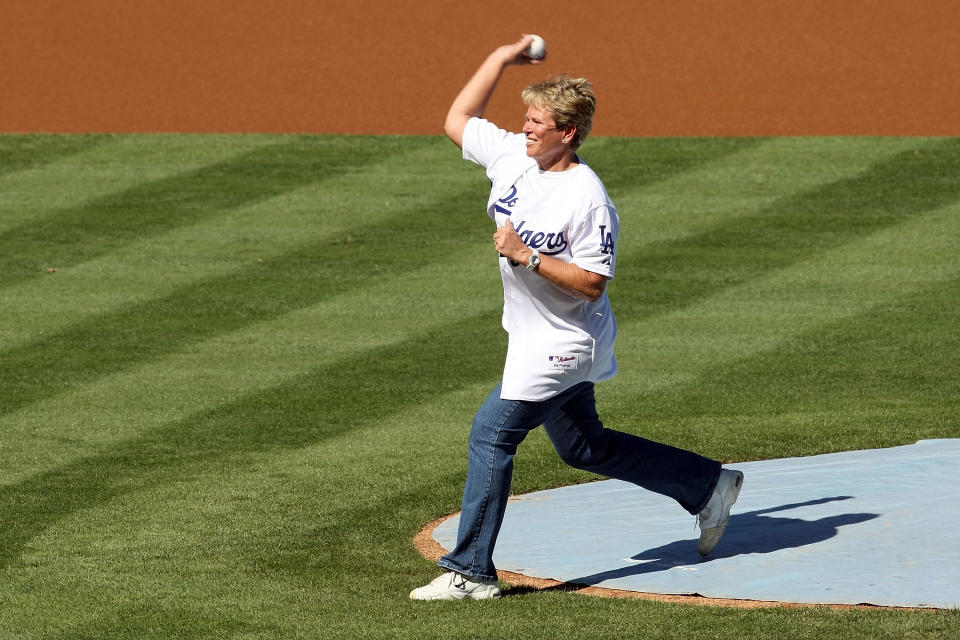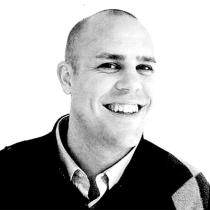40 years after trying out for the Indiana Pacers, Ann Meyers is still blazing trails

The press pulled no punches.
“Well, in case Ann doesn't make it,” Washington Post columnist Dave Kindred wrote in 1979 of Ann Meyers, the first woman to sign an NBA contract, “the Pacers say she'll stay with the team ‘in some capacity,’ which could mean, I guess, she'll cook pregame meals for the real players.”
Prospective teammates weren’t much kinder.
“This whole thing was done in L.A. by our owner, and I can’t possibly see how this can help us,” Pacers forward Mike Bantom told The New York Times 40 years ago on Sept. 5. “I think when you're trying to build a winner, this is no way to convince our fans that we are serious about our cause.”
Former New York Knicks owner Sonny Werblin even issued a statement.
“It's utterly ridiculous,” Werblin said of Meyers’ Indiana tryout. “It's disgraceful. I don't think the commissioner should condone it. I think it's bad for the image of pro basketball. It's a travesty.”
What few realized then and is only now coming into focus on the 40th anniversary of the day she signed a one-year, $50,000 contract to join the Indiana Pacers’ 1979 rookie camp: Ann Meyers Drysdale opened doors for a generation of women in basketball, and at 5-foot-9 she still stands tall in the game, long after her critics made exits. In order to understand how she got where she is today — a trailblazing front-office executive and broadcaster for the Phoenix Suns and Mercury — Yahoo Sports asked her about a door they tried to shut before it opened.
The contract
By the end of her tenure at UCLA, few, if any, women were so accomplished on the court. Meyers was the first prep player on the national team, eventually winning silver at the 1976 Montreal Olympics, the first woman to receive a four-year athletic scholarship from UCLA, the first four-time All-American women’s basketball player and the first player in Division I history — male or female — to register a quadruple-double. Meyers led the Bruins to a national title and was the No. 1 overall pick in the inaugural Women’s Professional Basketball League draft.
She was home in Southern California for two weeks in the summer of 1979, between leading the U.S. to a medal at the Spartacade Games in Russia and rejoining the team in Squaw Valley in preparation for the 1980 Moscow Olympics, when Pacers owner Sam Nassi telephoned.
“How would you like to try out for the Indiana Pacers?” asked Nassi, according to Meyers. Nassi had just bought the team, three years after the former ABA franchise’s entry into the NBA.
A decision did not come lightly for Meyers. By signing Nassi’s offer — a $50,000 personal services contract that provided opportunities in the organization even if she were cut — she would be relinquishing her amateur status and therefore foregoing her dream of Olympic gold. If Meyers was going to commit to the Pacers, she had to be convinced she could make the team.
“There’s no question that publicity was involved,” said Meyers, “but I never looked at it that way.”
She had grown up around some of the game’s greats, literally. She had five sisters and five brohters, one of whom was David Meyers, the NBA’s No. 1 overall pick in 1975 and a centerpiece of the Los Angeles Lakers’ trade for Kareem Abdul-Jabbar. She played pickup at Pauley Pavilion and in Las Vegas with the likes of Wilt Chamberlain, Julius Erving and Magic Johnson. She counts John Wooden as one of her greatest champions. And she relied on them for advice, for reassurance that her experiences on the pickup court could translate to the NBA.
“Even David was like, ‘Well, you know what you’re getting into,’” says Meyers. “He wasn’t against me, but he wasn’t like jumping for joy that this was happening. He was supportive. He was like, ‘You’ve gotta do what you’ve gotta do, Annie, but this league is a tough league.’”
In the end, it was the doubt that led her to the NBA. Pacers coach Bobby “Slick” Leonard flew to Los Angeles in hopes of persuading Meyers not to play. His appearance had the opposite effect.
“He was very much against this happening,” says Meyers. “One of the reasons that helped me make this decision, when I was in high school, I played on the boys’ summer league team, and I had every intention my senior year of playing on the boys’ basketball team, but I had people talk me out of it. ... Who would have thought five years later I’d have the same opportunity?”
So, she seized it. Not long afterward, President Jimmy Carter announced an Olympic boycott.
“It certainly changed my life,” Meyers says of what was a harrowing choice at the time. “If I don’t make that decision, I’m just one of the 1980 U.S. Olympians who don’t go to the Olympics.”

The tryout
Meyers wanted to focus on making the roster. The Pacers had other ideas. They held a press conference in L.A., where an unprepared Meyers stood beside Nassi and Leonard as the media asked, “Isn’t this just a gimmick to sell tickets?” She doesn’t remember a female among them. Then, they whisked her to New York, where she was set to appear on “Good Morning America.”
“Sandy Knapp, who was the head of public relations for the Pacers, was like 6-foot or 6-1, and anywhere we went, everybody thought that she was the basketball player,” Meyers remembers. “Even she said, ‘What is our organization coming to?’ Even in the organization, people were not happy about this girl coming to embarrass our organization. That was never my intent.”
All the while, the Meyers boys ran their sister through what can only be described as a “Rocky” montage — roughly six to eight hours of training a day, “running, basketball, hitting speed bags, jumping rope, conditioning, shooting, running stairs, whatever.” When she arrived in Indianapolis for the six practices over a three-day rookie camp at Hinkle Fieldhouse, she was in the best shape of her life at 24 years old. She was ready to ball. Again, everyone else had other ideas.
“As much media as was there, you can hardly find any footage,” says Meyers. “To me, that said they didn’t really take it seriously or think it was that important to save a lot of that information.”
Meyers was accustomed to playing with men. The reverse was not true. They treated her with kid gloves, and yet there she was drawing a charge on John Kuester during a one-on-one drill.
“I go down, and he’s like, ‘Annie, Annie, are you OK? Are you OK?’” says Meyers. “That’s when I knew it was harder for the guys, because their reaction was like they didn’t want to hurt me. My reaction was like: I’m fine, I’m getting up, and let’s just play. In essence, if they block my shot, big deal, it’s only a girl. If I make one, then it’s, ‘Ah, you let some girl beat you.’”
That all changed when Pacers assistant Jack McCloskey called everyone into a huddle during the second practice of the camp’s opening day, with a throng of cameras catching every minute.
“He just lit a tirade of verbiage, looking everybody up and down and basically saying, ‘She’s here to play. You’re here to play. Forget about the media. Quit worrying about her. She’ll take a hit,’” says Meyers. “It just kind of put them at ease with this laced, one-sided conversation. You could tell that the guys were just like, ‘OK, now I can play,’ because I’m sure it was hard on them physically and mentally. For me, it wasn’t as much, because I’d grown up with it.”
Meyers took her lumps and got off her shots. She set picks. She turned the ball over and stole it right back, picking the center clean when he brought a rebound too low. It was basketball. And by the end, when Leonard called her into his office, she felt she earned a training camp invite.
She was cut. The Pacers kept two rookies, Dudley Bradley and Tony Zeno. The former played for seven seasons over nine years, and the latter logged 59 minutes in eight career games.
“I wouldn’t have been there if I didn’t think I had a real shot,” says Meyers. “The decision was out of my hands. I did the best I could. From the beginning, I think it was very tough for Slick Leonard to accept, but he went through with what his owner said, and he said, ‘Great job.’ Jack McCloskey said, ‘Fundamentally, you’re better than half the guys out here.’ I understood the game. I was hurt. I felt that I had deserved to go past the three days. It was not easy to accept.”
“If she was six inches bigger and 40 pounds heavier, it would have been a different story,” Leonard told reporters after informing Meyers that her bid to join the Pacers had fallen short.
A few months later, the Pacers released Meyers from her deal. She never got the full $50,000.

The aftermath
A year after she was drafted No. 1 overall, Meyers joined the WBL, the same league that shunned her for joining the Pacers, publicly declaring it “a mockery of competitive athletics.” Her rights had been traded from Houston to New Jersey. She won co-MVP honors in her first season. They didn’t pay her full salary, either, so she held out, and the league soon folded.
Her experience with the Pacers earned her an invite to “Superstars,” a sports competition broadcast on ABC. Participants competed in a series of sports of all kinds. A seven-sport athlete in high school, Meyers won three straight seasons from 1981-83. It was there she met her husband, Hall of Fame pitcher Don Drysdale, a host on the show along with Bob Uecker.
“I remember in my tryouts there was a reporter who said, ‘You’re the Jackie Robinson of women’s sports,’” says Meyers. “Billie Jean King was still doing stuff, too, so to have that comparison was very, very flattering, but I thought to myself, No way am I Jackie Robinson. And who would’ve thought I would’ve married someone who played with Jackie Robinson.”
Her time with the Pacers included a brief stint as a broadcaster at the start of the 1979-80 season, another first in the industry. That later translated into work with NBC, CBS and ESPN, calling games in men’s and women’s college basketball, the WNBA and the Summer Olympics, as well as other sports. Her career has come full circle, leading back to the NBA, where she is an analyst for the Suns and a vice president in their front office. Just last year, she and Charlotte Hornets color commentator Stephanie Ready made history as analysts working the same game.
“Even though it didn’t turn out the way I had hoped it would, being part of the Pacers, it opened up so many doors for me,” says Meyers, who in 2012 published her autobiography, “You Let Some Girl Beat You,” complete with a foreword written by Dr. J. “My life has just been blessed because of one decision that a lot of people didn’t agree with, didn’t understand. When people give you a chance, why not take it? It may not work for them, they may think it’s wrong, but somebody believes in you, and that’s why I say don’t look back on your life and say, ‘What if?’”
If there were doors closed to women in the NBA, Meyers has opened a lot of them. There is no doubt her career carved a path for the dozens of women working in the NBA today as trainers, coaches and front-office executives. Last year, the Pacers named Kelly Krauskopf, who played for would-be 1980 U.S. women’s national team coach Sue Gunter in college, the first female assistant general manager in NBA history. Needless to say, the reception in Indiana was kinder.
“I’m grateful for the women who opened up doors for me, too, because they didn’t get the recognition, and they certainly deserve it,” says Meyers, making sure to mention Denise Long and Lusia Harris, the only two women ever drafted in the NBA. “If I don’t go to UCLA, if my brother’s not there, if John Wooden is not there to give us credibility, I don’t get the recognition and women’s basketball doesn’t get the recognition. That’s always how I’ve felt about it.”
Yet, Meyers says current players know little of her accomplishments — a now decades-long résumé in basketball that spans the NCAA, NBA, WNBA, USA Basketball and several of their predecessors. You can imagine the coverage a woman trying out for the Pacers would receive now, and Meyers is happy not to have had to face the added social-media firestorm. Besides, as she wrote in her book, “What matters is not that I was the first, but that I not be the last.”

The future
It’s a question that comes up now and again. Meyers has surely been asked it too many times to mention. Still, she receives it with intrigue. Could a woman ever actually play in the NBA?
The short answer: Yes. The long answer: It would have to be a guard with size or someone who can handle the ball like one. Dallas Mavericks owner Mark Cuban suggested in 2013 that he might draft Brittney Griner, but that would not have worked. “She’s definitely a center in the woman’s game,” says Meyers, and making the NBA would require a rare blend of size and skill, a player in the mold of Tamika Catchings, Candace Parker, Diana Taurasi or Elena Della Donne.
Meyers reframes the thinking when it comes to a woman playing the NBA. She is not suggesting the first woman would be a star or even a starter. A two-way player in today’s game might play as little as 48 minutes over the course of an entire season. Meyers has no doubt a woman could hold her own in that role. She had no doubt she could in 1979, back when NBA teams only carried 11 players. But it’s not necessarily the ability that is the biggest obstacle.
“It’s not so much the playing,” says Meyers, “it’s the grind of what the media is going to say, what other players from other teams are going to say, what girlfriends and wives are going to say. After a game, if a group of you go out as friends to eat or whatever, the innuendos that people would talk about. Even today it would happen. It would be all about behind the scenes.”
It’s a fascinating question, one long debated on sports radio. Forty years since her tryout in Indiana, nobody has a better perspective on the matter than Meyers, and that perspective comes with the knowledge that as far as women have come, there is still so much trail to blaze.
Our conversation turns to the patriarchal power structure and Showtime’s “The Loudest Voice,” starring Russell Crowe. “It’s so creepy,” she says, “and it’s still happening today.” She laments the pay gap between male and female athletes, whether it be the U.S. women’s soccer team earning less than the men or WNBA players having to play winters in Russia for a decent salary.
“It comes from the top and how they speak and how they treat people,” says Meyers. “That affects the rest of your business or the rest of your people. … So, the soccer team wins the World Cup, and they’re still not getting paid what the men are getting paid. It’s always like, Well, they don’t draw, they don’t do this, but it’s a support system. How can the women in the WNBA make more in a communist country, and you can’t make that kind of money in the WNBA?”
No matter how many times women prove them wrong, it seems under-qualified men suggesting they could beat WNBA players is a regular part of our news cycle. It happens almost constantly, Phoenix Mercury star Devereaux Peters wrote in a 2018 op-ed piece for The Washington Post.
“There are writers today who think they can play against the WNBA players,” says Meyers. “That’s 40 years ago that this guy wrote, ‘[she'll cook pregame meals for the real players],’ and yet you still hear today people say, ‘Well, they oughta go back in the kitchen and cook.’ That’s still being said. As much as we’ve moved forward, we still haven’t. … It’s still a long way to go.”
Forty years later, Ann Meyers Drysdale is still opening doors.
– – – – – – –
Ben Rohrbach is a staff writer for Yahoo Sports. Have a tip? Email him at rohrbach_ben@yahoo.com or follow him on Twitter! Follow @brohrbach
More from Yahoo Sports:


